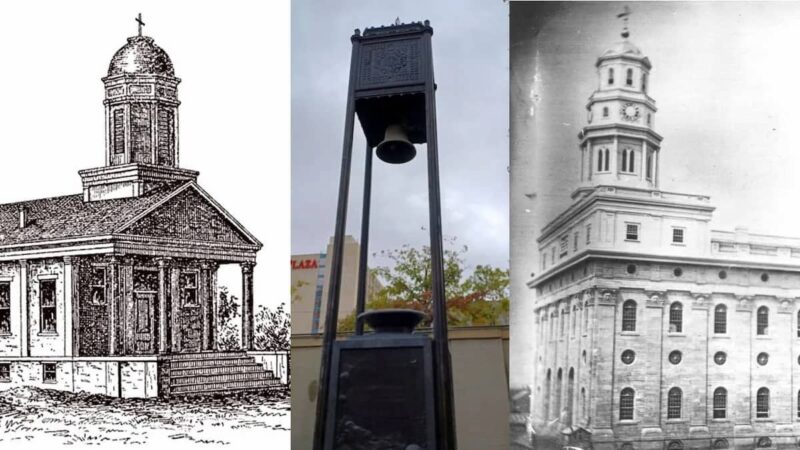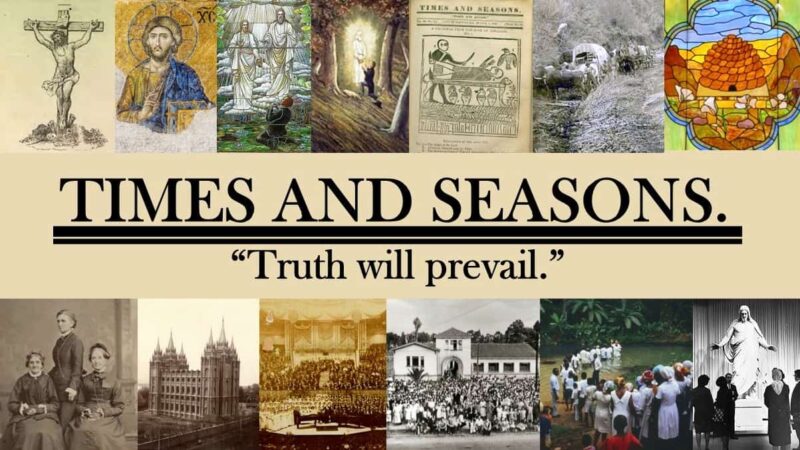Several months ago, I put out a post on the disappearance of the bell that has been on Temple Square for decades during the recent renovations. I shared the story of the bell, which has been called the Nauvoo Bell, but which is actually the Hummer Bell from a Presbyterian church in Iowa City. At the time, I wrote, “While it may not be the actual Nauvoo Bell, the Hummer Bell and the Relief Society Memorial Campanile have served the Church and community for far longer than the Nauvoo Bell even existed, taking on a life in its own right. And before the Bells at Temple Square was founded in 2005, the Hummer Bell was the most prominent bell at Temple Square.” Since then, the fate of the bell itself has become known – and it’s a fitting conclusion to a long saga. A new interview with Ronald G. Watt and Brian Warburton over at the Latter-day Saint history blog, From the Desk, shares details about one of the more persistent cases of mistaken identity in Latter-day Saint history, and where the bell is going next.
For decades, visitors to Temple Square were told they were looking at the bell that once rang out from the Nauvoo Temple tower. It became part of the Temple Square landscape—featured in pageants, broadcasts, and even housed in a campanile built by the Relief Society in the 1960s. The only problem? That bell wasn’t the Nauvoo Bell at all.
Instead, it was the so-called Hummer Bell, a Meneely bell from Iowa City that arrived in Utah under complicated circumstances involving contested ownership, a colorful theft, and eventually, a sale to the Church. The real Nauvoo Bell had cracked in the late 1840s and disappeared, likely repurposed into farm tools. As Ronald G. Watt explained it:
The temple bell was taken to Winter Quarters and used there to summon people to meetings. It was then carried to the Great Salt Lake in the spring of 1847 with the Charles C. Rich Company, the third company to cross the plains that year.
It was used to get everybody up in the morning, to begin their journey, and to warn the company of any possible Indian attacks.
When it arrived in Salt Lake City, it was placed in the fort and then went to Temple Square. It cracked during the winter of 1849-1850. There was some thought of melting it down and recasting it, but that was impossible. The metal was probably used for shovels and other necessary implements.
The Nauvoo Temple bell didn’t survive long in Utah, so the bell that was discovered in the archives was a different bell altogether.
The story of the Hummer Bell’s departure from Iowa is both entertaining and fascinating. I’ll leave the telling of the story of its theft from an Iowa City church and eventual purchase by the Church to the interview itself. But after the bell came into the possession of the Church, the origins of the bell gradually became obscure:
After its purchase by Calkin, the Hummer bell was stored at the tithing yard until early in the twentieth century, when it was transferred to the Bureau of Information. The bell was discovered by Nephi L Morris, who was prominent in both Church and Utah State affairs.
Morris did some research into the Nauvoo Bell’s history that included the stories that came from the David Lamoreaux family. With that material, he and President Joseph J. Cannon, president of the Temple Square Mission, were convinced that the old bell in the basement was the Nauvoo Bell.
On June 17, 1939, the Deseret News published an article headlined “Haunting Tone of Nauvoo Temple Bell Rings Out Anew.”
This became the basis of the bell’s story when it was introduced to Temple Square.

Beginning in the late 1990s, however, letters from the First Presbyterian Church in Iowa City began the process of discovering the true history of the bell:
Ronald G. Watt: In 1998, the Church Historical Department received a letter about the bell from Iowa City, asking for at least a picture of the bell and
if the bell does exist and whoever owns it would be willing to part with it we would be willing to negotiate and would be more than willing to come and get it or pay to have it shipped.
At the time, I was handling all correspondence sent to the Church Archives. I wrote back and told him the only bell that had come to Salt Lake at that time was the Nauvoo Bell. It had been cracked, melted down, recast, and now resided on Temple Square. …
In 2000, the Public Affairs Department sent an intern to the Church Archives and Church Library. The Church was considering sending the bell back to Nauvoo. I told her about the history of the bell and gave her a copy of my research and paper. I advised that she contact the Smithsonian and find an expert on bells.
She talked to David Shayt, an associate curator. He told her that the bell on Temple Square was a MeNeeley Bell made in the nineteenth century. He also said that it was impossible to melt a bell down and recast it with more metal. The sound would be tinny. Besides, a skilled bell craftsman would be needed, and Salt Lake did not have any such artisan in the valley at the time.
That convinced me that I had been wrong.The Nauvoo Temple Bell had cracked and disappeared sometime after 1849. The metal had probably been used for some type of farm implement, like a shovel.
It had become apparent that the bell was not the Nauvoo Bell after all.
After about twenty years, an opportunity to act on the research that had been performed arose. As Brian Warburton wrote:
he Relief Society Campanile and the bell were removed from Temple Square as part of the overall renovation process of the Salt Lake Temple and surrounding grounds in 2023.
The Church History Department was asked what we thought should be done with the bell at that time. We felt that the bell ought to be returned to the congregation in Iowa if it still existed.
After I did some research to verify that the current First Presbyterian Church in Iowa City was indeed the same descendant entity, we recommended that the bell be offered to them.
This recommendation was approved by the Presiding Bishopricin early 2024. Keith Erekson, Director of Research and Outreach in the Church History Department, contacted the leadership of the First Presbyterian Church in Iowa City to see if they would like the bell to be returned to them.
They were elated, and we began the process of returning the bell to them as well as working out timing and shipping logistics.
As a result, the bell has been returned to Iowa and will soon be dedicated in its proper home:
The Hummer Bell will be proudly displayed outside the First Presbyterian Church in Iowa City, where it will once again be used to call congregants to worship services.
The First Presbyterian Church began a fundraising campaign to erect a new bell housing near their current meetinghouse. The Church of Jesus Christ of Latter-day Saints made a significant contribution to this fundraising effort and paid all shipping costs.
The new housing was completed and the bell installed earlier this month (September 2025), and an official dedication ceremony is planned on October 5, 2025. That day, local members of the Church of Jesus Christ of Latter-day Saints and congregants of the First Presbyterian Church plan to come together in celebration of the bell’s return. The combined congregations also plan to expand and continue service projects with a local food pantry in the Iowa City community.
As I hinted at up front, I am sad to see the bell leave, but it is a fitting conclusion to the saga of the Hummer Bell to have it returned to its rightful owners.
You can read the full interview about the Nauvoo Bell with Ronald G. Watt and Brian Warburton over at the Latter-day Saint history blog, From the Desk.

Comments
2 responses to “The Nauvoo Bell That Wasn’t”
I like truth over myths.
Glad to see the Church take responsibility and set things right. What a heartwarming story!